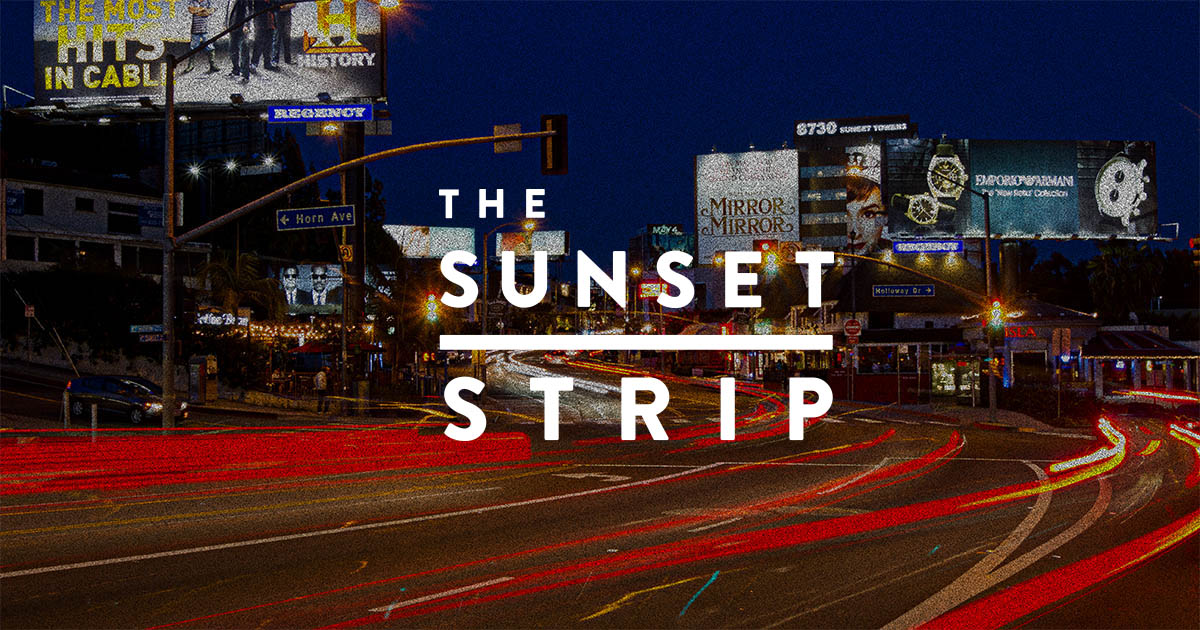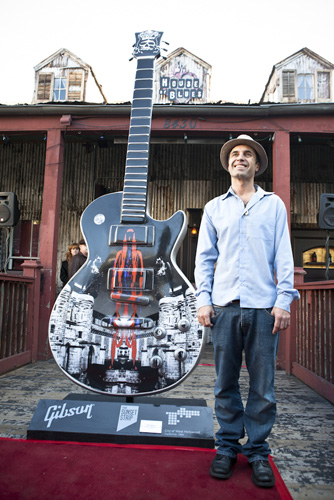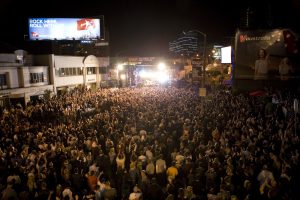This summer The Sunset Strip partnered with Gibson Guitar to launch a public art exhibit celebrating the people and places that have shaped the boulevard. Southern California photographer Nic Adams was one of the artists selected to customize a 10-foot fiberglass art guitar as part of the “GuitarTown Sunset Strip” exhibit. We recently caught up with him to discuss his career photographing a who’s who of personalities and icons – from Pharcyde to Eddie Vedder to Dennis Hopper – his photography philosophy, and how it happened that he ended up creating a giant guitar celebrating the Prince of Darkness.
Do you remember the first photo you ever took?
Thanks for that question because I haven’t thought about it before. I think it was at the beach, of my first girlfriend Nicole, on black-and-white film when we were about 16…in some sea caves we hiked to by Newport Beach.
Her father had given her his Canon A1. That’s the camera I started shooting with, [and] I still use Canon when it’s an SLR camera. It stands out in my mind since I went and printed some of those in the darkroom. They’re probably my first prints. I took a class at school shortly after that.
As a Southern California native, what were your early memories/impressions of The Sunset Strip?
The Sunset Strip, I remember, was pretty crazy. The first show I went to was X and Oingo Boingo in O.C. in the summer of 1982. After that I was into the punk scene and began going to shows around L.A. and hanging out in Hollywood sometimes. There was a clothing store on Melrose called Poseurs that we would catch a ride to from someone old enough to drive or we’d just hitchhike. It was the only place to get Doc Martins, studded and spiked bracelets, Mod, Ska, and other Punk gear unless mail ordered through fanzines. I’d mostly hang out around that area.
Sometimes we went to The Strip, but I was pretty young still. It was much more of a rock and roll party animal vibe back then. It was good to kind of stand back and watch. The punk scene had nothing on glam metal when it came to extreme fashion. I could never really understand the day-glow animal print spandex though!
Toward the end of the ’80s I was going to shows sometimes at the Whisky and The Roxy. I went to study abroad in 1990 and I traveled a lot from that point on. I’d see shows of friends’ bands like Human Waste Project on The Strip when I was in town.
Most memorable shoot?
For me, the most memorable shoots are from personal experiences. An out-of-body-like experience with Steve Graham heliboarding in Alaska on an island near Juneau as the sun was setting on one side and the full moon was rising on the other…[The photo was used for a Surfrider Foundation campaign.]
Pharcyde in Paris for the day, Booyah Tribe at their house in Carson, Nicole Lenz at the Marilyn Monroe estate in Palm Springs, and Eddie Vedder for a project he was doing with director Marc Rocco for the Into the Wild movie.
…But, I’d have to say Dennis Hopper was a big favorite. It was in Vegas in 2007 at a golf course. When I introduced myself, he was a little surprised and asked if someone had put me up to play a joke on him. Nick Adams was his first roommate when he had came to L.A. I told him my grandparents had met Nick Adams many times, and he’d been to their house, so I knew his story but didn’t know about their connection.
They wanted me to shoot on the green in the midday sun in Vegas. Being a photographer, he noticed I didn’t like the light where we were shooting. He said, “You’re not liking this so where do you want to shoot?” I pointed up a hill by a building and we walked off by ourselves. I didn’t shoot much — once I had the shots, we just talked about art, photography, film and digital cameras, women, his art show in Saint Petersburg Russia he was going to from Vegas, and who to talk to about publishing a book of some of my early work. He was really inspirational to meet.
Travel, fashion, live music, portraits: What’s your favorite subject matter to photograph?
It’s a hard question for me to answer. I look at light as a form, and I try to work within the shapes I see created in the light field. Interacting with people is the part of doing photography that pulled me in as an avenue to experience new places and perspectives. I’ve shot pretty much what’s around me since I started. It’s still very much the same now, but refined.
The class I took in school was documentary photography. If I heard of a band playing somewhere that I was into, I would bring my camera. Skateboarding was a big part of my world then so I would shoot some of the people I would skate with around Southern California.
I went snowboarding for the first time when I got back from studying abroad, and I started to shoot some of my friends in the local mountains and Mammoth. I captured the lifestyle in those worlds and started getting published in editorials and ads. I moved to Paris in the early ’90s and freelanced with magazines all over the world. After a short while, I met Stephane Herve while he was forming Rage magazine, where I worked and was focused on music photography until about 2000. Some of the people I lived with were modeling and I begun shooting fashion, too. When I returned to L.A. I got involved with filmmakers I knew and picked up a lot of techniques from [directors of photography] and gaffers. So I like to shoot everything, and I approach each subject differently.
What other mediums do you work with?
Mixed-media, mostly. Polaroid – I’m finishing up my black-and-white Polaroid art nude series printed on canvas, which I’ve been doing for about two years. They’re shot with a Polaroid Land Camera from the ’60s on high-speed Polaroid black-and-white film that is no longer made and extremely rare. It’s pretty much a dead medium. Some are [on my website] to check out. I’ll be publishing that sometime this year.
And anything else I get my hands on: video, drawing, painting and writing. I really like collaborations with other artists. I’m working on projects with a nonprofit artist collective called Mission Control that do Space Wench and Space Island at Burning Man. It’s inspiring to put things together and find a connection between them that isn’t evident. Technology and its endless possibilities have held an attraction since I began creating with the camera.
Why Ozzy as a subject matter?
He’s the Prince of f*cking Darkness! Come on!
Can you describe your creative process with the guitar sculpture from initial ideas to execution?
I got the guitar in the studio and had an anxiety attack. Haha, just kidding. Well kind of….
Originally, I had a completely different idea about the concept of the guitar as an entity. The idea came from conversations I have had with musicians about their interaction with the instrument as if it was a girlfriend or relationship. That concept was using one of the Polaroid images, painting dust and scratches, and a stenciled street art elements.
When the Ozzy tribute became my part of the project it switched to an approach using iconography from Ozzy’s legacy. I was not seeing it working with the form of the guitar. The original entity concept and Prince of Darkness kept repeating in my head. I paced back and forth for a day staring at the guitar, but didn’t know what I was going to do until I went and laid down in a hammock that night. As cheesy as it sounds, I was looking at the stars and I channeled it, divine inspiration, or got a visit from the Prince of Darkness? The image of the guitar flashed in my head pretty close to exactly how it looks now with images I had shot in Europe of Chateau de Vincennes in Paris, the griffins from very old fountains in Innsbruck, Austria, and the shroud-like image. I immediately went in, picked up the masking tape and spray paint, and didn’t stop working on it until it got delivered.
What music were you listening to? What were your inspirations while working on this project?
I have always listened to every kind of music. I was listening to a lot of electronic music and dubstep while around people at Mission Control. That wasn’t working for inspiration on this project so I listened to Sabbath, Ozzy, KLOS classic rock, Rage Against The Machine, NIN and most KROQ staples. That worked well.
As an artist, what does it mean to have your work displayed in such a highly publicized fashion, as part of a public art project on The Sunset Strip?
It is truly incredible. The charity aspect drew me to it in the beginning, and I was excited to stretch my boundaries on such a unique project. I really didn’t realize how big it was at all until the signing with Ozzy and Slash at House Of Blues on The Sunset Strip [Jan. 10]. It was surreal. I am very honored.
For more information about Nic Adams, including photos of his works, visit www.nicadams.com. GuitarTown Sunset Strip is currently on display along the 1.6-mile boulevard. The guitars will be auctioned this fall with proceeds benefitting charities.
Photo courtesy Erik Voake.
–Brent X Mendoza




Average Rating